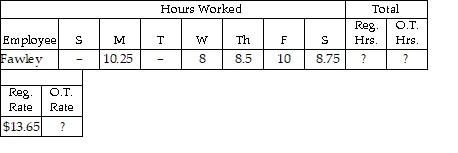Find the volume.
A. 218 ft3
ft3
B. 20 ft3
ft3
C. 198 ft3
ft3
D. 72 ft3
ft3
Answer: A
You might also like to view...
For the functions f(x) and g(x), determine the domain of (f + g)(x) (the sum of f and g).f(x) =  , g(x) = 6x2 - 5
, g(x) = 6x2 - 5
A. {x ? x is a real number} B. {x ? x is a real number and x ? -6} C. {x ? x is a real number and x ? 0} D. {x ? x is a real number and x ? 5}
Find the present value. Round to the nearest cent.To get $2000 after 12 years at 8% compounded semiannually
A. $811.45 B. $780.24 C. $1219.76 D. $794.23
Find the hours, rate, or earnings as specified. Find the number of regular hours, overtime hours (over 40), and overtime rate (time and a half).
Find the number of regular hours, overtime hours (over 40), and overtime rate (time and a half).
A. 36.75, 8.75, $27.30 B. 45.5, 0, $20.48 C. 40, 5.5, $20.48 D. 40, 5.5, $27.30
Answer the question.The graph below shows the level curves of a differentiable function f(x, y) (thin curves) as well as the constraint g(x, y) =  -
-  = 0 (thick circle). Using the concepts of the orthogonal gradient theorem and the method of Lagrange multipliers, estimate the coordinates corresponding to the constrained extrema of f(x,y).
= 0 (thick circle). Using the concepts of the orthogonal gradient theorem and the method of Lagrange multipliers, estimate the coordinates corresponding to the constrained extrema of f(x,y).
A. (1.1, 1.1), (-1.1, 1.1), (-1.1,-1.1), (1.1,-1.1) B. (1.3, 0.7), (-1.3, 0.7), (-1.3,-0.7), (1.3,-0.7) C. (1.5, 0), (0, 1.5), (-1.5, 0), (0, -1.5) D. (1.5, 0.2), (0.7, 1.3), (-1.5, 0.2), (-0.7, 1.3), (-1.5, -0.2), (-0.7, -1.3), (1.5, -0.2), (0.7, -1.3)